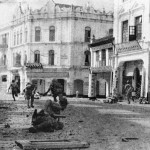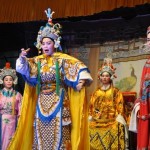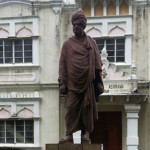Burmese in Penang
We have no records of the earliest Burmese arrivals to Penang. However, we know that after 1800, there was a large Burmese settlement in the area between Bagan Jeramal and Pulau Tikus. The Burmese also settled in Batu Maung.
The earliest settlers were fishermen who came by fishing boats and established a colony – probably at Telok Ava, near the present Chinese cemetery in Telok Bahang. The early burial ground of the Burmese was a plot of land in front of Casuarina Hotel, probably the car park site.
Most of the early Burmese community were concentrated in the Burmese Village in Pulau Tikus. There were also nearby fishing settlements along the coast. Early paintings depicted the “Burmese Temple” (painted by Captain Edward H. Locker, 1805) and a house named “MacKinnon’s Residence near Burmese village” (painted by James Wathen, 1811) in the Pulau Tikus area.
The original site of the temple land was purchased by Nonia Betong from George Layton for 390 spanish dollars. The temple was founded on 1st August 1803 and named the Nandy Moloh Temple. The four trustees were all ladies: Nonia Betong, Nonia Meerut, Nonia Koloh and Nonia Bulan.
The Burmese community expanded, and together with the Thai Buddhist community they appealed to Queen Victoria of England for land to build bigger temples and burial grounds for elders. Queen Victoria through the East India Company granted land jointly for the Siamese and Burmese communities to erect their temples.
The Burmese Temple Trustees (1845) were Nong May & Bon Khan. Later, on the demise of the above trustees, three Burmese trustees were added: Koo Pao, Poh Oh and Changerig. The temple pagoda appears in an early painting (John Turnbull Thomson, 1848). In 1948, the Penang court appointed Maung Pho Min, Maung Shoey Nee and Maung Shoey Dong to administer the trust.
The Chief Monks of the temple were as follows:
The late Ven. U Nandamala 1803-1842
The late Ven. U Sutti 1842-1865
The late Ven. U Vicara 1865-1897
The late Ven. U Nanavamsa 1897-1922
The late Ven. U Jagara 1922-1957
The late Ven. U. Vimala 1957-1972
The late Ven. U Paranavamsa 1972- present
The Burmese are devout Buddhists. In recent years, much of the Buddhist Temple, including the old Simla Hall, has been redeveloped and new Buddha statues added, through the generous donations of devotees. The Burmese Buddhist festivals are Soon Dawgyi, Kathina celebration (offering of money tree and Kathina robes), Wesak Day Procession and Water Festival.
The Burmese were traders who conducted barter trade. They were also famous for cigar manufacturing. Some of the educated ones were civil servants, such as surveyors, station masters and clerks. A few became professionals, such as doctors.
The Burmese cigar factory was pioneered by Sin Yew Kyong (1890-1961). His wife was a Nonya by the name of Khoo Lean Sim. Coming to Penang at age 16, Sin later set up a “choorut” or cigar factory and company, Guan Hin, at 8, Tavoy Road, Penang. This factory employed about 300 Burmese choorut rolling factory girls in the 1930s. Sin later opened a cigar shop at 22 Prangin Lane, Penang, and a factory at 19 Eastern Road, Taiping, Perak. The factory was managed by his two sons Sin Hock Leong and Sin Tien Ho.
Many of the cigar factory girls were sought after as wives for the Chinese immigrants.
Through intermarriage, the Burmese integrated with other ethnic communities in Penang. The following are stories of two Burmese families in Penang.
Oral history by Dato’ Mary J. Ritchie
My grandmother Mah Nyong (1840-1921) came from Burma to Penang, trading in gem stones. My father Maung Shoay Tong was a trader, selling herbal cures and bicycles. He loved music and was active in community work. My mother Meh Itt Chanradvirode was born in Phuket, Thailand. She was active in giving herbal cures and healing injuries. My parents had 10 chlidren (7 sons and 3 daughters). My eldest sister is Mah Seng Yin and my eldest brother is Maung Song Seng. My uncle Maung Shoay Tee worked as a surveyor. He retired and stayed in Taiping. My aunt’s name was Mah Meek.
Oral history by Nyee Aye Toolseram
My grandfather was Dr. Hari Singh Thulasiram (Dr. Harrison Toolseram) of Burmese Indian origin. He had his clinic in Chulia Street. My grandmother Mah Poh Siew was of Burmese Chinese origin. My auntie, June Toolseram married Mr. Devosse of Dutch origin. My uncle Jan Toolseram married a Nyonya around the year 1941.
My father Puteh or Phu Thay (1898-1969) worked as a ledger clerk and a meter reader inspector. His first marriage was to Winnie Bamford of Dutch origin (circa 1904-1939). They had 4 sons and 2 daughters. His second marriage was to my mother Keng Choo or Peh Nyet of Burmese Chinese origin (1915-1960). They had 2 sons and 4 daughters.
My father took part as a violin player in the Bangsawan performances organised by the Chinese Amateur Dramatic Association in aid of China Distress Relief Fund on 17-18 August, 1928. My
uncle on my mother’s side is Maung Toon Meng, and he married a Chinese wife. There used to be a Penang Burmese Buddhist Association, according to a picture taken around 1941.
Future
Looking back at our history, we are proud to be the Penang Burmese community. As a minority, the questions we should ask are, what will happen to our community in the future? Will our religion and culture survive after 200 years of the history of Penang?
In view of the questions asked, we, a group of Penangites, have registered an organisation named Penang Burmese Society, with a mission to carry on our Burmese heritage and culture. Presently, we are planning, developing and strategising interesting programmes to promote Burmese living culture and traditions. We hope everyone (including the State government) can give full support to further our mission.
Thanks to friends and relatives who helped in the preparation of this presentation.
Mary J. Ritchie and Nyee Aye Toolseram


